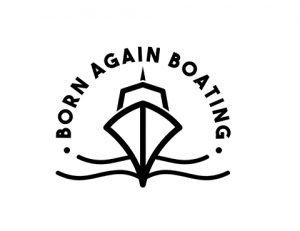Sometimes I run across someone’s boat that will just not keep the fuel primed up. Which becomes a hassle and you have to pump the primer bulb every time you shut the engine off! So what do you do, you ask?
Why Does My Outboard Lose Prime? Outboard engines lose fuel prime because of an air leak in the fuel system. Somewhere between the engine and the fuel tank.
Here are the best and quickest ways to troubleshoot and resolve this issue!
What Are The Symptoms of An Air Leak?
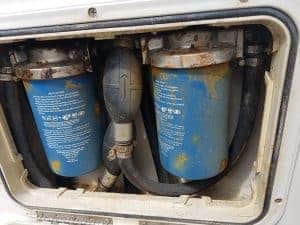 There are really only a couple of symptoms for a leak in the fuel lines to the engine. Either the engine randomly runs out of fuel and dies. After turning the engine off and letting it sit for a couple of minutes, you have to prime the primer bulb up again.
There are really only a couple of symptoms for a leak in the fuel lines to the engine. Either the engine randomly runs out of fuel and dies. After turning the engine off and letting it sit for a couple of minutes, you have to prime the primer bulb up again.
Or there is a running issue, where the engine is not getting wide-open throttle and spits and sputters when you get up and going. Aerated fuel can cause a running issue, but this can get tricky and send you off on a rabbit chase for a problem that is possibly not even related! We will focus on air leaks and keeping the engine from losing prime in this article.
Understanding Different Engines
There are different causes to this depending on your engines. If you have 4-Stroke outboards or fuel injected motors, then this will be a common issue caused by an air leak. 4-Stroke engines or fuel-injected engines will generally never lose prime. The engines store fuel in either a VST or an FSM. (What is an Outboard FSM or VST?)
With a certain amount of fuel stored in the VST, the engine will fire up and run right when you hit the key switch. Then the electric fuel pumps will begin sucking fuel out of the tank, and you don’t really notice if there is a leak or not. That is unless it is a pretty bad leak!
2-Strokes on the other hand, that is a different story! Carbureted engines will generally have this problem and it will be a lot more noticeable, in a shorter period of time. Generally, if there is no issue, you can turn the engine off for a couple of hours and never lose prime. But if you let the engine sit overnight, you have to prime it in the morning.
Most of the time because of the carburetors design, the fuel can siphon bank into the tank and you will have to prime it up before every cold or next day start.
Visually Inspect The Fuel Lines
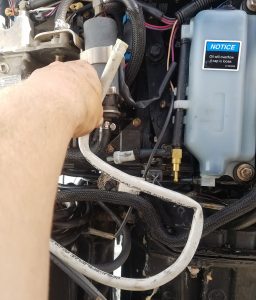 The first thing we want to do is a visual inspection of the entire fuel line. Starting at the engine. Follow along the fuel line moving it around and looking at it.
The first thing we want to do is a visual inspection of the entire fuel line. Starting at the engine. Follow along the fuel line moving it around and looking at it.
Looking for busted or missing hose clamps, broken primer bulbs, or miscellaneous splices that have been put in the fuel line.
Extensions in fuel lines, to save old fuel hoses, create weak spots. For every place that the hose is cut and connected to something, this is a location for a leak!
Check over the boat fuel filter and its fittings. Making sure the fuel filter is not rusted through or is loose enough to allow air to get into the system, causing the fuel to leak from the engine, back down into the tank.
Where To Start Troubleshooting
We will want to start our troubleshooting process by obtaining a small say 1-foot long clear hose and a coupling hose barb, that is the same size diameter as your fuel line. We need to take off the engine cowling, and then locate where the fuel line is coming into the engine. Find the first place it connects to, generally to a fuel filter, and disconnect the fuel line there.
Insert the clear hose into the fuel line, prime up the engine, and start it up! Let it run for a little while and carefully watch the fuel passing through the clear hose.
If you see a ton of air bubbles coming from the boat fuel tank side of the hose, then we are hot on the trail to solving this issue!
Follow The Bubbles!
Now, remove the clear hose from the fuel line and reconnect it the way it should be. Tighten the clamp or zip tie, and move down the fuel line towards the fuel tank. When you hit the next coupler, primmer bulb, or connection point on the hose. Reinstall the clear hose there and retest for more bubbles.
You can also skip a good portion of this process if you want to go directly to the tank and test before following the bubbles. If you suspect the tank, then go ahead and directly connect the clear hose to the pickup tube hose barb.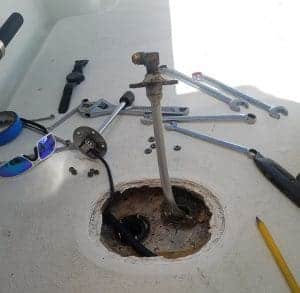
Retest and see if you have bubbles. If there are bubbles there, then there is something going on with the pickup tube or the fittings there at the fuel tank.
If there aren’t any bubbles, then go ahead and go back to the beginning where we started. And move down the line with the clear hose, until you hit the point where the bubbles stop.
Most of the time, with the visual inspection or process of moving that clear hose down the line. You will find a broken hose barb fitting or cracked pick up tube.
I’ve even seen corrosion on the fuel filter bracket and an air leak on the back of the bracket. You would never be able to tell from just looking at it. But as I moved the clear hose along the line. Boom! Bubbles on one side, and straight solid fuel on the other!
Fix-It & Get It Done!
Now that you have located the leak, fix it! There is not much more to it than that! Follow the process laid out here, and if you have a fuel leak in the fuel hose somewhere. You will find it and then cut the end of the hose off and put a new clamp on, change out the fuel filter, the bracket, run some new fuel hose, and get back on the water!
Something To Know About Fuel Hoses.
Know that not all fuel lines are made equally!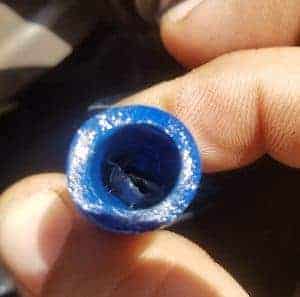 If you have blue, or gray fuel hoses. Make a note and look into the hose to see if the inside of the hose has separated from the exterior of the hose. Blue and gray fuel lines, (mostly the blue lines), are known for separating.
If you have blue, or gray fuel hoses. Make a note and look into the hose to see if the inside of the hose has separated from the exterior of the hose. Blue and gray fuel lines, (mostly the blue lines), are known for separating.
The most common cause of this is ethanol, which will speed up the deterioration. But the hoses themselves are just cheap!
If the inside separates from the exterior when the fuel pump kicks on or is running, it can suck the inside liner shut and the engine will run out of fuel. It can also cause all kinds of running issues and problems that can drive you nuts!
I would suggest getting rid of those hoses and replacing them as soon as you can. Ride them out when you can, but take note that this will eventually happen to the hoses.
Properly Priming a Primer Bulb!
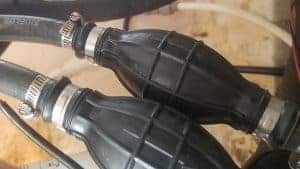 Something that a lot of people miss is improperly pumping the primer bulb! Yes, there is an incorrect way of priming the primer bulb! Who would have known?
Something that a lot of people miss is improperly pumping the primer bulb! Yes, there is an incorrect way of priming the primer bulb! Who would have known?
If the primer bulb is held horizontally. Then most of the time, it will not prime anything at all! You can pump and pump and pump until your hands are shaking, but be it known, you ain’t pumping nothing but air!
Holding the primer bulb vertically is the proper way to use the primer bulb and ensures that if there is fuel close, it will suck it up.
How To Prime Up Fuel When Primer Bulb is Air Locked
Another thing to know about primer bulbs is that if the fuel leaks to far back into the tank. The primer bulb can’t suck it up without removing it.
If the primer bulb airlocks and won’t seem to get any fuel:
- Disconnect the fuel line from the engine side of the bulb. With the arrow pointing to the side where you pulled the hose off.
- Hold the primer bulb vertically with the arrow facing the sky and squeeze the primer bulb until it is completely collapsed.
- Then, stick your finger on the hose barb.
- Let go of the primer bulb.
- Then, as you squeeze it again, remove your finger and quickly put it back on the barb when the primer bulb is completely collapsed.
- Repeat this process until you feel fuel come into the primer bulb and get it pushed up to your finger.
- Then reconnect the fuel hose on the bulb and prime that bad boy up!
Hint: If you pump and pump and pump and never get any fuel out. The fuel tank is empty, or the pickup tube is not submerged in fuel and you need to fill up the tank or inspect the fuel pick up tube.
Check Us Out On YouTube!
Check out our channel and get subscribed! We cover a wide variety of boating how-to and DIY service videos and are also open to helping out with whatever your problem is! Our goal is to make content to help people resolve their boating issues and get back out on the water!
We mainly focus on outboards and outboard boats. Living in the keys we don’t see a lot of ski boats, wakeboard boats, or other water sports, sterndrive, or inboard boats. We will do what we can and hopefully, we’ll be able to help you out!
If you’ve got any questions or comments, let us know by subscribing to our YouTube Channel!
And if you would like to support us to continue bringing you great content, please click the link below to Amazon where we get a commission from anything you are already going to buy!
And you can also donate by clicking the donate button here or on the right hand of the screen!
It really helps us out and we thank you so much for your support!
Thanks for reading and we look forward to reading your responses and comments.
